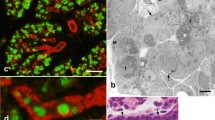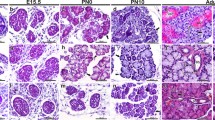Abstract
Using a battery of monoclonal antibodies specific for rat proteins, immunohistochemistry was carried out on the developing myoepithelial cells (MECs) of the rat major salivary glands. The proteins examined were α-smooth muscle actin (αSMA), h1-calponin (calponin), keratin 14 (K14), β subunit of S-100 protein (S-100β), vimentin and glial fibrillary acidic protein (GFAP). The MECs exhibited immunoreactivity for αSMA, calponin and K14, but not that for S-100β, vimentin and GFAP. Immunoreactivity for αSMA appeared in the MECs from the time when the microfilaments were initially deposited in these cells, i.e., at 20 days in utero in the sublingual and submandibular glands and at birth in the parotid gland. Calponin immunoreactivity was seen 1 day earlier than αSMA. The appearance was almost at the same time as the onset of the MEC differentiation in each gland. A small number of the MECs expressed weak K14 immunoreactivity from the time when the acinus-intercalated duct structure was established, i.e., at 21 days in utero in the sublingual gland, at 5 days after birth in the perotid gland and after 5 weeks post-natally in the submandibular gland. In addition, K14 immunoreactivity was observed in the basal cells of the striated and excretory ducts. The first appearance of K14 in these cells again coincided with the emergence of the duct system in each gland, i.e., at 20 days in utero in the sublingual gland, at 21 days in utero in the submandibular gland and at 3 days after birth in the parotid gland. Finally, the MECs in all the glands were found to redistribute as the acini matured. As the acini grew rapidly during the weaning period in the parotid and the sublingual glands, the MECs ceased to surround the acini. Thereafter, they disappeared from the acini in the parotid gland, whereas they reappeared in the sublingual gland. In the submandibular gland, the MECs were confined to the terminal tubules until 4 weeks after birth. Thereafter, the acini were established and invested by the MECs. In conclusion, immunohistochemistry of calponin and αSMA is a useful tool for identification of the MEC during its earliest differentiation, which has hitherto been possible only electron microscopically. In addition, it is suggested that the MEC is heterogeneous and the functionally differentiated MEC appears after weaning around acini of the mucous and seromucous glands.
Similar content being viewed by others
Author information
Authors and Affiliations
Additional information
Accepted: 11 January 1999
Rights and permissions
About this article
Cite this article
Ogawa, Y., Yamauchi, S., Ohnishi, A. et al. Immunohistochemistry of myoepithelial cells during development of the rat salivary glands. Anat Embryol 200, 215–228 (1999). https://doi.org/10.1007/s004290050274
Issue Date:
DOI: https://doi.org/10.1007/s004290050274




